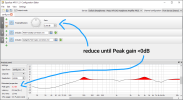Apologies if this is a newbie question that has been asnwered before - but if so, I couldn't find the answer either on this forum or elsewhere.
The DAC I have (SMSL d6s) only has one set of stereo outputs , which is feeding my main bookshelf speakers via the 'balanced' out to an amplifier, and also sending (the same) signal to a subwoofer via a pair of stereo RCA cables.
The subwoofer has an in-built amp, with an adjustable low-pass filter. The amplifier for the bookshelves has has not Eq / filtering capability of its own (Audiophonics s125nc, or somesuch).
What I'm trying to understand is what the 'correct' procedure would be, for using REW to measure the setup, and generate a set of 'filters'/eq-paramters that I could put to EqAPO to get the best in-room response for this 2.1 system. I have a Umik-1 to do the measurements with, and have worked through a few 'tutorials' for how to Eq the bookshelves on their own.
From most of the tutorials I've read / seen, they seem to either assume that REW is used to generate filters for a 'stereo setup' (i.e. one pair of speakers), or for integrating a pair of stereo speakers, with a subwoofer fed via a different set of outputs (e.g. via a MiniDSP). there are also some tutorials that look feeding a fully-active 2.1 system studio monitor system via a stereo system, but those assume that both the mains and subwoofer have additional low/high-pass adjustments of their onw. In my case - whatever gets sent to the bookshelves will be full-range.
So, since I don't have an access to a 3 or 4 channel DAC - what would be the standard/best approach towards room correction of a 2.1 system, with a 2.0 feed from a DAC?
Any advice is warmly welcome !
The DAC I have (SMSL d6s) only has one set of stereo outputs , which is feeding my main bookshelf speakers via the 'balanced' out to an amplifier, and also sending (the same) signal to a subwoofer via a pair of stereo RCA cables.
The subwoofer has an in-built amp, with an adjustable low-pass filter. The amplifier for the bookshelves has has not Eq / filtering capability of its own (Audiophonics s125nc, or somesuch).
What I'm trying to understand is what the 'correct' procedure would be, for using REW to measure the setup, and generate a set of 'filters'/eq-paramters that I could put to EqAPO to get the best in-room response for this 2.1 system. I have a Umik-1 to do the measurements with, and have worked through a few 'tutorials' for how to Eq the bookshelves on their own.
From most of the tutorials I've read / seen, they seem to either assume that REW is used to generate filters for a 'stereo setup' (i.e. one pair of speakers), or for integrating a pair of stereo speakers, with a subwoofer fed via a different set of outputs (e.g. via a MiniDSP). there are also some tutorials that look feeding a fully-active 2.1 system studio monitor system via a stereo system, but those assume that both the mains and subwoofer have additional low/high-pass adjustments of their onw. In my case - whatever gets sent to the bookshelves will be full-range.
So, since I don't have an access to a 3 or 4 channel DAC - what would be the standard/best approach towards room correction of a 2.1 system, with a 2.0 feed from a DAC?
Any advice is warmly welcome !
